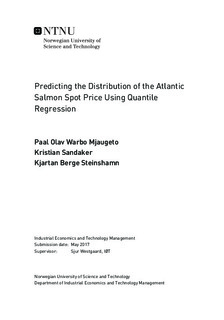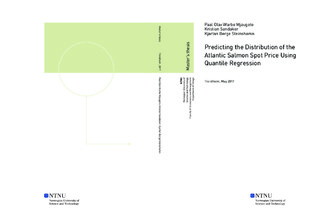| dc.description.abstract | The growth in salmon farming production has outperformed the average growth in aquaculture production during the last decades. Alongside this growth, the industry has strengthened its presence in the capital markets. However, the salmon price has become increasingly volatile, imposing uncertainty and additional costs across the entire value chain. This motivates the development of more accurate price distribution prediction models. Such models can support operational and financial considerations that are subject to price uncertainty, such as harvest timing, futures hedging, and investments.
This study aims to provide a framework for predicting the distribution of the Atlantic salmon spot price, and to identify the most important exogenous drivers in this respect. The spot price is represented by the NASDAQ Salmon Index (NQSALMON), denoted in USD. We build on a database of 25 carefully selected explanatory variables, and design a 1- to 12-month ahead quantile regression prediction model for the spot price. Each of the twelve months to be predicted are appointed a designated submodel, which is independent of the other submodels. Moreover, each submodel utilises eight explanatory variables that are selected from the database using a novel genetic algorithm-assisted variable selection approach.
There are several encouraging results from this study. First, the approach with a genetic algorithm for variable selection in quantile regression quickly finds submodels with favourable goodness-of-fit. Generally, the 2- to 7-month submodels explain slightly more variation in the NQSALMON distribution compared to the 8- to 12-month submodels. Regarding model specification, the regressions provide the correct unconditional coverage; however, the exceedances at quantiles are often clustered. This might be the result of unexplained, non-linear effects and higher-order statistical moments. However, the quantile regression equation specification error test (QRESET) suggests that linear quantile regression in most cases is a sound functional form for the given data. Finally, the results indicate that exogenous variables such as standing biomass, feed consumption, and prices of alternative proteins are important predictors of the future spot price of Atlantic salmon. | |

